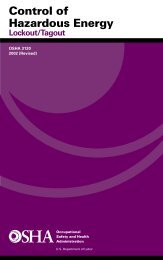Toxic Chemical Release Inventory Reporting Forms and Instructions
Toxic Chemical Release Inventory Reporting Forms and Instructions
Toxic Chemical Release Inventory Reporting Forms and Instructions
Create successful ePaper yourself
Turn your PDF publications into a flip-book with our unique Google optimized e-Paper software.
Appendix C<br />
” M95 Transfer to Waste Broker — Waste<br />
treatment.<br />
Quantities of an EPCRA section 313 chemical, except<br />
metals <strong>and</strong> metal category compounds, sent off-site to<br />
a POTW should also be reported in Section 8.7. If you<br />
know, however, that a chemical is not treated for<br />
destruction at the POTW you should report that<br />
quantity in Section 8.1 instead of 8.7.<br />
To report correctly EPCRA section 313 chemicals in<br />
Section 8.7, use the following equation.<br />
§8.7 =§6.1 (excluding most metal/metal category<br />
compounds) + §6.2 (treatment) – §8.8 (off-site<br />
treatment due to catastrophic events) 3<br />
” <strong>Reporting</strong> quantities in Section 8.8 “Quantity<br />
released to the environment as a result of remedial<br />
actions, catastrophic events or one-time events not<br />
associated with production processes.” The<br />
quantities that are reported in Section 8.8 are associated<br />
with non-production related activities such as<br />
catastrophic releases <strong>and</strong> remedial actions, as well as<br />
one-time events not associated with routine production<br />
practices, that were disposed or released directly to the<br />
environment or transferred off-site for the purposes of<br />
recycling, energy recovery, treatment or disposal.<br />
Quantities reported in Section 8.8 must not be reported<br />
in Section 8.1 through 8.7.<br />
” <strong>Reporting</strong> the production ratio in Section 8.9. A<br />
production ratio or activity index must be provided in<br />
Section 8.9. A zero is not acceptable <strong>and</strong> “NA” (Not<br />
Applicable) can be used only when the reported<br />
EPCRA section 313 chemical was not manufactured,<br />
processed, or otherwise used in the year prior to the<br />
reporting year.<br />
” Calculating production ratio in Section 8.9. In<br />
calculating a production ratio for “otherwise used”<br />
chemicals, an activity index must be used rather than<br />
quantities purchased or released from year to year.<br />
” <strong>Reporting</strong> source reduction activities in Section<br />
8.10. It is an error to report a source reduction activity<br />
in Section 8.10 <strong>and</strong> not report at least one method used<br />
to identify that activity <strong>and</strong> vice versa.<br />
3 §8.8 includes quantities of toxic chemical disposed or<br />
otherwise released on-site or managed as waste off-site due to remedial<br />
actions, catastrophic events, or one-time events not associated with the<br />
production processes.<br />
D. FDP Messages Used to Report Notices<br />
of Significant Errors<br />
Note: EPA is continually trying to improve the error checking<br />
system for TRI submissions. As a result, a small number<br />
of the error messages in this appendix will be changed by<br />
the time the <strong>Reporting</strong> Year 2002 submissions are<br />
checked. Most of these messages will remain the same.<br />
You can look for changes to these error messages on the<br />
TRI home page at <br />
1. You have used an invalid Form R or Form A by using<br />
either a form not applicable for the reporting year, or a<br />
facsimile form that has not been approved by EPA.<br />
Resubmit your data on a current EPA approved Form<br />
R or A.<br />
2. Pages were missing from the form received. Correct<br />
this by resubmitting a complete certified form for this<br />
chemical substance.<br />
3. Multiple chemicals were reported in your Form R. You<br />
must submit a separate <strong>and</strong> complete Form R for each<br />
chemical cited.<br />
4. You have provided a valid CAS number <strong>and</strong> a valid<br />
chemical name, but they do not match. Respond by<br />
providing a valid CAS Number <strong>and</strong> matching <strong>Chemical</strong><br />
Name.<br />
5. You have left part or all of the chemical identification<br />
sections blank. Respond by providing a valid CAS<br />
Number <strong>and</strong> matching <strong>Chemical</strong> Name or Mixture<br />
Component Identity.<br />
6. You reported a CAS number <strong>and</strong>/or chemical name that<br />
are invalid. Respond by providing a valid CAS Number<br />
<strong>and</strong>/or matching <strong>Chemical</strong> Name.<br />
7. Your form indicated Trade Secret status with an<br />
indication that this form is a Sanitized version, but the<br />
report contains no Generic <strong>Chemical</strong> Name. You must<br />
provide a Generic <strong>Chemical</strong> Name for this sanitized<br />
form.<br />
8. You did not sign the Form or certification letter. Per<br />
EPCRA Section 313(g)(1)(B), each submission must<br />
contain an original signature certifying the accuracy<br />
<strong>and</strong> completeness of the information reported by<br />
signing the certification statement on the Form or<br />
certified letter. Please be sure to sign the certification<br />
statement in this FDP to certify your submission data.<br />
9. You have reported a Persistent Bioaccumulative <strong>Toxic</strong><br />
(PBT) chemical on a Form A. PBT chemicals (e.g.,<br />
Dioxin <strong>and</strong> Dioxin-like Compounds, Lead Compounds,<br />
Mercury Compounds <strong>and</strong> Polycyclic Aromatic<br />
Compounds (PACs)) are not eligible for the alternate<br />
<strong>Toxic</strong>s <strong>Release</strong> <strong>Inventory</strong> <strong>Reporting</strong> <strong>Forms</strong> <strong>and</strong> <strong>Instructions</strong> C–9
















